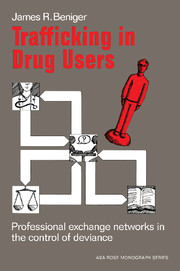Book contents
- Frontmatter
- Contents
- Acknowledgments
- Introduction
- 1 The emergence of the “drug problem”: social change versus social control
- 2 Control systems from exchange in networks: toward a synthesis of system and action theory
- 3 Stratification in information and referral exchange
- 4 Exchange relationships in social-control systems
- 5 The social system: boundary maintenance and hierarchical control
- 6 Summary: the control system in context
- Appendix A The data set
- Appendix B Subgroup sampling and estimated-density spaces (EDS)
- Notes
- Bibliography
- Name index
- Subject index
6 - Summary: the control system in context
Published online by Cambridge University Press: 07 May 2010
- Frontmatter
- Contents
- Acknowledgments
- Introduction
- 1 The emergence of the “drug problem”: social change versus social control
- 2 Control systems from exchange in networks: toward a synthesis of system and action theory
- 3 Stratification in information and referral exchange
- 4 Exchange relationships in social-control systems
- 5 The social system: boundary maintenance and hierarchical control
- 6 Summary: the control system in context
- Appendix A The data set
- Appendix B Subgroup sampling and estimated-density spaces (EDS)
- Notes
- Bibliography
- Name index
- Subject index
Summary
The emergence of a so-called drug problem among American youth in the latter half of the 1960s remains one of the most rapid and dramatic social changes in U.S. history. In a period of only a few years, the use of psychoactive drugs spread from a deviant activity of the socially marginal to a major societal problem thought to afflict – or at least to threaten – the nation's youth in general. As we have seen, this sudden emergence of a national drug problem had a profound impact on community systems for the control of deviance among youth, with increasing pressures for change on three organizational systems: the health system, the law-enforcement and criminal-justice system, and the educational system.
The response of this total system for the social control of youth to the sudden “disturbance” constituted by the drug problem has been the central focus of this study. Although the disturbance to the control system was eventually contained by it, this did not occur without strain on various organizational facilities, strains that reverberated upward from facilities to mobilization channels to norms until the tension finally eased under a new balance of “control” relationships. The details of precisely how this occurred constitute an excellent case study of a much more general sociological phenomenon: the control by organizational systems of exogenous social change.
Much of the organizational response to social change, for example, the shift of government money and other resources to the new problem, may be related more to public perceptions than to more objective measures of the problem.
- Type
- Chapter
- Information
- Trafficking in Drug UsersProfessional Exchange Networks in the Control of Deviance, pp. 158 - 174Publisher: Cambridge University PressPrint publication year: 1984



